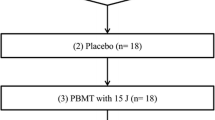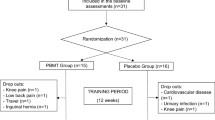Abstract
The purpose of this study was to investigate the effectiveness of adding photobiomodulation therapy and neuromuscular electrical stimulation (NMES) to volleyball athletes’ training, focusing on muscle strength and jumping skills. Thirty-six athletes were randomly placed into three groups: control, photobiomodulation therapy, and NMES. The athletes trained to improve their muscle strength and jumping skills. The athletes in the photobiomodulation therapy group were submitted to photobiomodulation therapy (850 nm, continuous, energy density 0.8 J/cm2, radiant energy per point 6 J, total radiant energy 36 J) before undergoing strength and plyometric training. The NMES group additionally underwent NMES-based quadriceps femoris muscle strength training (base frequency 1 kHz, frequency modulation 70 Hz, intensity maximum tolerable). The variables analyzed were muscle strength, jumping ability, global impression, and jump frequency; they were measured at baseline and during follow-ups at 6 and 8 weeks. The statistical analysis was conducted on an intention-to-treat basis. The between-group differences and their respective 95% CIs were calculated using linear mixed models by using group, time, and group-versus-time interaction terms. Dominant lower limb strength improved the most in the NMES group compared to the control group (mean difference = 1.4, 95% CI = .5 to 2.4). Non-dominant lower limb strength increased in both the photobiomodulation therapy group (mean difference = 1.1, 95% CI = .3 to 2) and the NMES group (mean difference = 1.9, 95% CI = 1.1 to 2.8) compared to the control group, but the NMES group improved more than the photobiomodulation therapy group (mean difference = 0.8, 95% CI = 0.1 to 1.7). The NMES group had the greatest improvement in global perceived effect scale compared to the control group (mean difference = 1.1, 95% CI = 1 to 2.2). Dominant lower limb strength improved in the NMES group compared to the control group. Non-dominant lower limb strength increased in both the photobiomodulation therapy group and the NMES group compared to the control group, but the NMES group improved significantly more than the photobiomodulation therapy group; the NMES group also improved in the global perceived effect scale compared to the control group. This study found that, for volleyball athletes, photobiomodulation therapy and NMES both promoted benefits in terms of muscle-strength gain. In addition, these benefits were maintained for 2 weeks even after training was interrupted. Dominant lower limb strength improved in the NMES group compared to the control group. Non-dominant lower limb strength increased in both the photobiomodulation therapy group and the NMES group compared to the control group, but the NMES group improved significantly more than the photobiomodulation therapy group; the NMES group also improved in global impression of jumps compared to the control group.




Similar content being viewed by others
References
Canavan PK, Vescovi JD (2004) Evaluation of power prediction equations: peak vertical jumping power in women. Med Sci Sports Exerc 36(9):1589–1593
Bahr MA, Bahr R (2014) Jump frequency may contribute to risk of jumper’s knee: a study of interindividual and sex differences in a total of 11 943 jumps video recorded during training and matches in young elite volleyball players. Br J Sports Med 48(17):1322–1326
Markovic G (2007) Does plyometric training improve vertical jump height? A meta-analytical review. Br J Sports Med 41(6):349–355
Ziv G, Lidor R (2010) Vertical jump in female and male volleyball players: a review of observational and experimental studies. Scand J Med Sci Sports 20(4):556–567. https://doi.org/10.1111/j.1600-0838.2009.01083.x
Malisoux L, Francaux M, Nielens H, Theisen D (2006) Stretch-shortening cycle exercises: an effective training paradigm to enhance power output of human single muscle fibers. J Appl Physiol 100(3):771–779
Baroni BM, Junior ECPL, De Marchi T, Lopes AL, Salvador M, Vaz MA (2010) Low level laser therapy before eccentric exercise reduces muscle damage markers in humans. Eur J Appl Physiol 110(4):789–796
De Marchi T, Junior ECPL, Bortoli C, Tomazoni SS, Lopes-Martins RÁB, Salvador M (2012) Low-level laser therapy (LLLT) in human progressive-intensity running: effects on exercise performance, skeletal muscle status, and oxidative stress. Lasers Med Sci 27(1):231–236
Maffiuletti NA, Bramanti J, Jubeau M, Bizzini M, Deley G, Cometti G (2009) Feasibility and efficacy of progressive electrostimulation strength training for competitive tennis players. J Strength Cond Res 23(2):677–682. https://doi.org/10.1519/JSC.0b013e318196b784
Malatesta D, Cattaneo F, Dugnani S, Maffiuletti NA (2003) Effects of electromyostimulation training and volleyball practice on jumping ability. J Strength Cond Res 17(3):573–579
Maffiuletti NA, Dugnani S, Folz M, Di Pierno E, Mauro F (2002) Effect of combined electrostimulation and plyometric training on vertical jump height. Med Sci Sports Exerc 34(10):1638–1644. https://doi.org/10.1249/01.MSS.0000031481.28915.56
Bax L, Staes F, Verhagen A (2005) Does neuromuscular electrical stimulation strengthen the quadriceps femoris? Sports Med 35(3):191–212
Hortobágyi T, Maffiuletti NA (2011) Neural adaptations to electrical stimulation strength training. Eur J Appl Physiol 111(10):2439–2449
Ferraresi C, Hamblin MR, Parizotto NA (2012) Low-level laser (light) therapy (LLLT) on muscle tissue: performance, fatigue and repair benefited by the power of light. Photonics Lasers Med 1(4):267–286
Huang Y-Y, Sharma SK, Carroll J, Hamblin MR (2011) Biphasic dose response in low level light therapy–an update. Dose-Response 9(4):dose-response. 11-009. Hamblin
Leal-Junior ECP, Vanin AA, Miranda EF, de Carvalho PTC, Dal Corso S, Bjordal JM (2015) Effect of phototherapy (low-level laser therapy and light-emitting diode therapy) on exercise performance and markers of exercise recovery: a systematic review with meta-analysis. Lasers Med Sci 30(2):925–939
Balady GJ, Chaitman B, Driscoll D, Foster C, Froelicher E, Gordon N, Pate R, Rippe J, Bazzarre T (1998) Recommendations for cardiovascular screening, staffing, and emergency policies at health/fitness facilities. Circulation 97(22):2283–2293
Jenkins PA, Carroll JD (2011) How to report low-level laser therapy (LLLT)/photomedicine dose and beam parameters in clinical and laboratory studies. Photomed Laser Surg 29(12):785–787
Burns SP, Spanier DE (2005) Break-technique handheld dynamometry: relation between angular velocity and strength measurements. Arch Phys Med Rehabil 86(7):1420–1426
Bohannon RW (1990) Hand-held compared with isokinetic dynamometry for measurement of static knee extension torque (parallel reliability of dynamometers). Clin Phys Physiol Meas 11(3):217–222
Harman EA, Rosenstein MT, Frykman PN, Rosenstein RM, Kraemer WJ (1991) Estimation of human power output from vertical jump. J Strength Cond Res 5(3):116–120
de Salles P, Vasconcellos F, de Salles G, Fonseca R, Dantas E (2012) Validity and reproducibility of the sargent jump test in the assessment of explosive strength in soccer players. J Hum Kinet 33:115–121
Da Cunha RA, Costa LOP, Hespanhol LC, Pires RS, Kujala UM, Lopes AD (2013) Translation, cross-cultural adaptation, and clinimetric testing of instruments used to assess patients with patellofemoral pain syndrome in the Brazilian population. J Orthop Sports Phys Ther 43(5):332–339
Twisk JW (2013) Applied longitudinal data analysis for epidemiology: a practical guide. Cambridge university press, Cambridge
Garcia AN, Costa LCM, Hancock MJ, de Souza FS, de Oliveira Gomes GVF, de Almeida MO, Costa LOP (2018) McKenzie method of mechanical diagnosis and therapy was slightly more effective than placebo for pain, but not for disability, in patients with chronic non-specific low back pain: a randomised placebo controlled trial with short and longer term follow-up. Br J Sports Med 52(9):594–600
Hollis S, Campbell F (1999) What is meant by intention to treat analysis? Survey of published randomised controlled trials. Bmj 319(7211):670–674
De Villarreal ES-S, Requena B, Newton RU (2010) Does plyometric training improve strength performance? A meta-analysis. J Sci Med Sport 13(5):513–522
Leal Junior ECP, Lopes-Martins RAB, Baroni BM, De Marchi T, Rossi RP, Grosselli D, Generosi RA, de Godoi V, Basso M, Mancalossi JL (2009) Comparison between single-diode low-level laser therapy (LLLT) and LED multi-diode (cluster) therapy (LEDT) applications before high-intensity exercise. Photomed Laser Surg 27(4):617–623
Gorgey AS, Wadee AN, Sobhi NN (2008) The effect of low-level laser therapy on electrically induced muscle fatigue: a pilot study. Photomed Laser Surg 26(5):501–506
Junior L, Pinto EC, Lopes-Martins RÁB, Rossi RP, De Marchi T, Baroni BM, de Godoi V, Marcos RL, Ramos L, Bjordal JM (2009) Effect of cluster multi-diode light emitting diode therapy (LEDT) on exercise-induced skeletal muscle fatigue and skeletal muscle recovery in humans. Lasers Surg Med 41(8):572–577
Leal Junior ECP, Lopes-Martins RÁB, Dalan F, Ferrari M, Sbabo FM, Generosi RA, Baroni BM, Penna SC, Iversen VV, Bjordal JM (2008) Effect of 655-nm low-level laser therapy on exercise-induced skeletal muscle fatigue in humans. Photomed Laser Surg 26(5):419–424
Vanin AA, Verhagen E, Barboza SD, Costa LOP, Leal-Junior ECP (2018) Photobiomodulation therapy for the improvement of muscular performance and reduction of muscular fatigue associated with exercise in healthy people: a systematic review and meta-analysis. Lasers Med Sci 33(1):181–214
Ferraresi C, de Brito Oliveira T, de Oliveira Zafalon L, de Menezes Reiff RB, Baldissera V, de Andrade Perez SE, Júnior EM, Parizotto NA (2011) Effects of low level laser therapy (808 nm) on physical strength training in humans. Lasers Med Sci 26(3):349–358
Author information
Authors and Affiliations
Corresponding author
Ethics declarations
Conflict of interest
The authors declare that they have no conflict of interest.
Ethical approval
The Research Ethics Committee of the University Federal of São Paulo approved this study.
Informed consent
Informed consent was obtained from all individual participants included in the study.
Additional information
Publisher’s note
Springer Nature remains neutral with regard to jurisdictional claims in published maps and institutional affiliations.
Rights and permissions
About this article
Cite this article
da Cunha, R.A., Pinfildi, C.E., de Castro Pochini, A. et al. Photobiomodulation therapy and NMES improve muscle strength and jumping performance in young volleyball athletes: a randomized controlled trial study in Brazil. Lasers Med Sci 35, 621–631 (2020). https://doi.org/10.1007/s10103-019-02858-6
Received:
Accepted:
Published:
Issue Date:
DOI: https://doi.org/10.1007/s10103-019-02858-6




